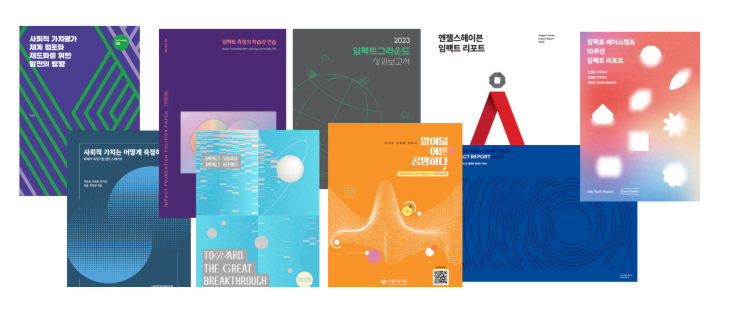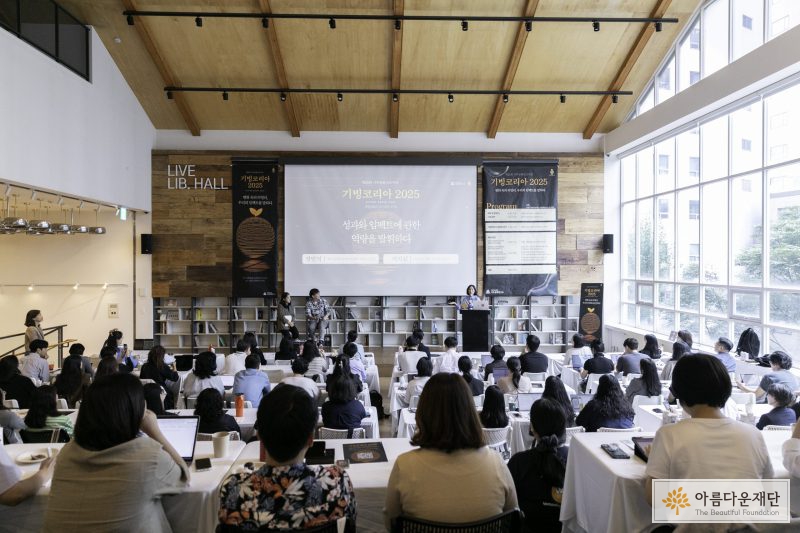The term “impact” is no longer unfamiliar in Korea’s nonprofit ecosystem. Today, not only boards and donors but also front-line activists are eager to understand the social outcomes their work creates. Since 2015, nonprofits have been experimenting with ways to conceptualize and measure their social contributions, and these conversations have grown even more vibrant in recent years.

At the Giving Korea 2025 Conference, Center on Philanthropy at The Beautiful Foundation hosted a panel session to explore how diverse actors—field organizations, impact measurement institutions, and intermediary organizations—experience and practice “impact.”
Field Organization Case 1
LGBTIQ Youth Support Center DDing Dong
“Impact measurement is not just evaluation—it’s about asking why we exist.”
Jung Min-seok, Chairperson of Dding Dong, reflected that their first impact measurement in 2023 became a profound moment of introspection. Over a decade, the organization has provided counseling, crisis intervention, and empowerment programs for LGBTQ youth. Through the measurement process, Dding Dong sought to capture not only quantitative outcomes but also the deeper stories and emotions behind them. Jung asked, “Is a higher number of counseling cases really our impact?” emphasizing that the meaning lies beyond numbers. He stressed that true impact comes from sharing results and turning them into broader social conversations. “There’s no public interest work without impact. It’s about how we reveal and use it. Real impact culture embraces both success and failure as part of learning.”
Field Organization Case 2
The Beautiful Foundation – ‘Eighteen Years Old Adults’ Campaign
“We already had the data—we just didn’t know where to look.”
Manager Seo Ji-won from The Beautiful Foundation shared insights from the Adults at Eighteen campaign, launched in 2019 to shift social perceptions of care leavers. Instead of speaking for them, the campaign empowered them to become agents of change. Seo noted that the measurement process began with one key question: “What truly drives change, and how much have we contributed to it?” Following the Theory of Change framework, the team examined shifts among campaigners, participants, and society at large. To their surprise, most of the needed data already existed—in reports, plans, and content archives—and organizing it took nearly four months. “Impact measurement is not a technical task. It’s like learning a new language. Every effort to solve social problems already holds change within it.”
Measurement Institution Case 1
Korea Social Impact Valuation (KSVA)
“Measurement is not about scores—it’s about connecting languages.”
Director Kim Su-jin explained that measurement should bridge different “languages” among stakeholders—those of field workers, corporations, and donors. Beyond metrics, it must translate emotions, behaviors, and contextual stories into shared understanding. She emphasized that measurement experts should help quantify what matters to the field—such as safety or self-determination in counseling, or loneliness in community projects. She also highlighted the importance of creating spaces for internal dialogue, so that reports become tools for reflection and learning rather than one-way communication. “Even when funders want numbers, teach them your language, let the field’s perspective define what impact truly means.”
Measurement Institution Case 2
Impact Research Lab
“Impact measurement should be a learning journey, not a performance report.”
Ha-eun Kim, CEO of Impact Research Lab, shared her talk titled “Why Do Impact Reports Make Me Uncomfortable?” She argued that discomfort often arises when reports fail to capture opportunities for learning and improvement.
“Evaluation should not aim for perfect reports, but for better collaboration and problem-solving.”She urged nonprofits to embrace “productive discomfort” as the starting point of impact—to learn and grow through shared reflection.
Intermediary Organization Case 1
Center for Social value Enhancement Studies(CSES)
“Impact measurement is a means for organizational growth.”
Team Leader Yoo Mi-hyun shared insights from the Impact Foundation Learning Community, a network she helped facilitate over four years. Starting with six foundations, it has grown to over 30, fostering peer learning and experimentation. Yoo emphasized that those closest to the work should design and measure impact themselves.“Experts can advise, but real insight comes from practitioners. By building their own indicators, they reduce fear and internalize the meaning of impact.”The community’s findings show measurable improvements in staff capability and decision-making, proving that even small-scale measurement can lead to big organizational learning.
Intermediary Organization Case 2
BRIAN Impact
“The real value lies not in data itself, but in reading and discussing it together.”
Director Cho Sang-wook introduced Impact Ground, a major philanthropic experiment supported by Kakao Impact, which has funded 21 innovation organizations with a total of 25 billion KRW (approx. 17 million USD). Rather than focusing on short-term results, the project sought scalable, transformative ideas. One standout example was OCEAN, a private research institute tackling marine waste through AI and citizen participation. Cho noted that its work demonstrated how measurement could fuel innovation itself. “Meaningful data builds trust. Measurement becomes a shared journey of empathy, learning, and dialogue—inside and outside the organization.”
In today’s Korean nonprofit ecosystem, impact is becoming the language of collaboration. When field experience, research insight, and organizational networks intersect, the stories hidden behind numbers emerge. Impact, then, is not the end result, it is the beginning of conversation, learning, and growth.
